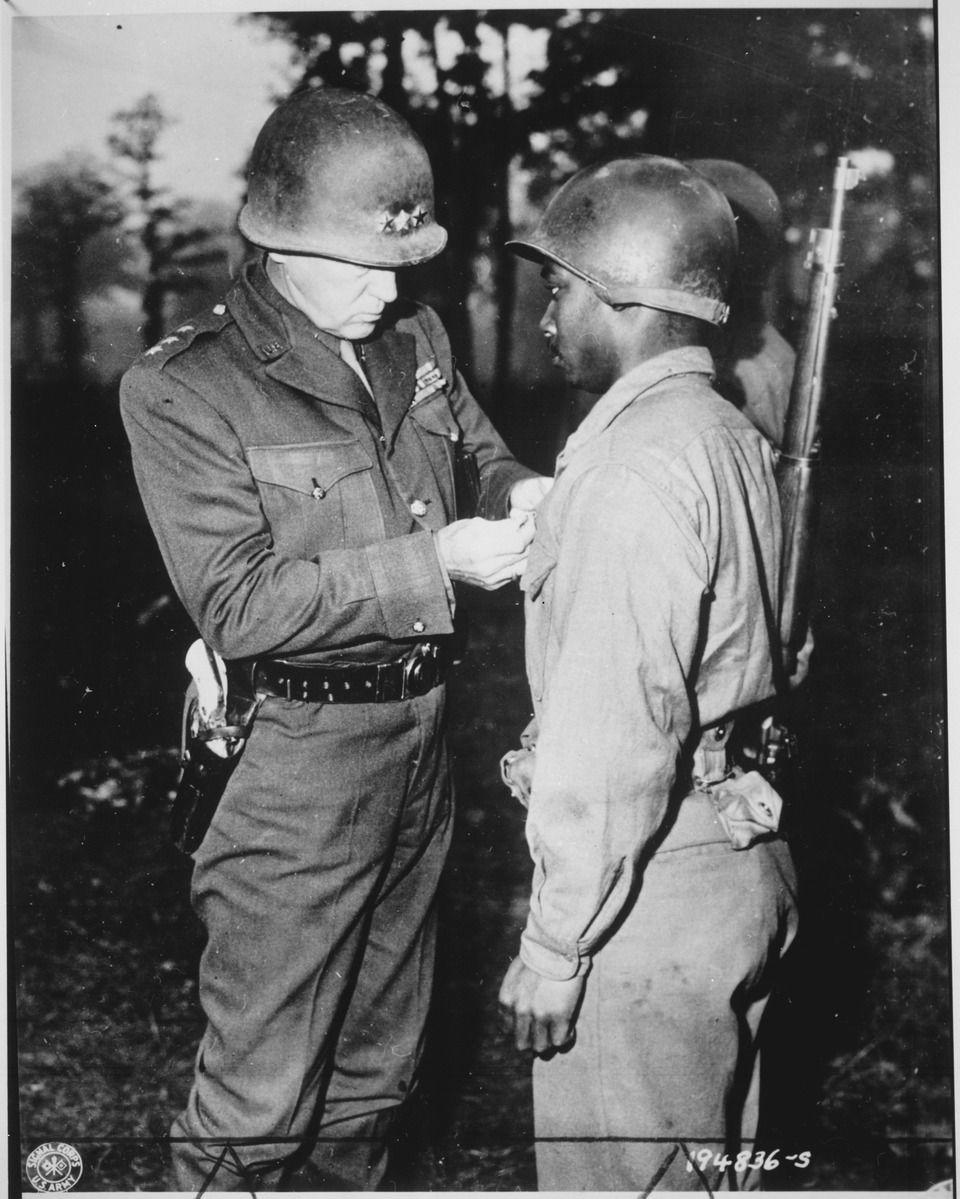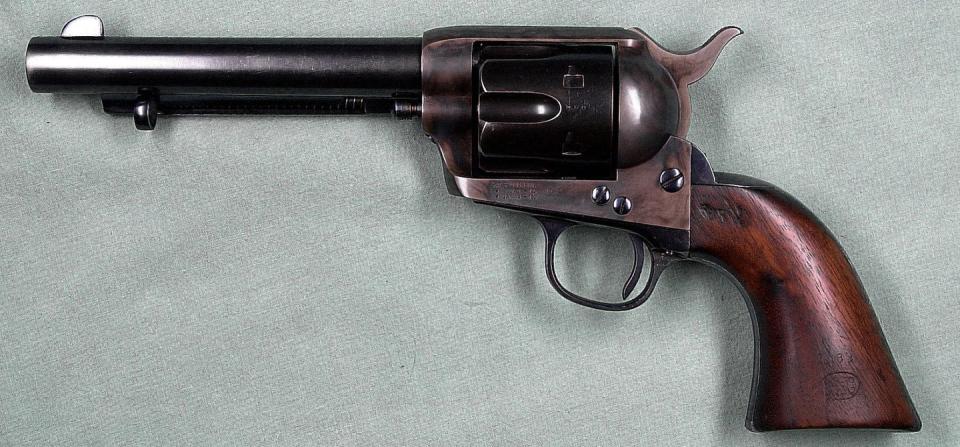The Colt Single Action Army Is the Revolver That Changed Everything
On October 26, 1881, shots rang out at the O.K. Corral. Within the first 30 seconds of the shootout, three members of the Clanton gang were killed. Men on both sides, including Wyatt Earp, Doc Holliday, and Billy Clanton, would become legends in part because of what happened in Tombstone, Arizona. They were firing a legendary weapon, too.
The Colt Single Action Army held many names over the years. First came its clunky official title, the New Model Army Metallic Cartridge Revolving Pistol. But soon it became known as the Frontier, the Equalizer, the Model P, and most famously, the Peacemaker.
There was no peace that October day in Tombstone. But the shootout was one of many that cemented the reputation of this six-chamber gun that saw more than 20 years service with the United States Army and became the iconic revolver of the West.
DIVE DEEPER ➡ Read best-in-class military features and get unlimited access to Pop Mech , starting now.
The Predecessors
To trace the story of the Colt 45, you have to go back 45 years before the O.K. Corral to when Samuel Colt patented his first percussion revolver design in February 1836. Colt plugged away on wooden models and technical drawings until Baltimore gunsmith John Pearson forged a working prototype. Colt soon set up the Patent Arms Company in Paterson, New Jersey. The town gave its name to Colt's first production revolver: "The Paterson."
The early models required the barrel to be removed before the pistol's cylinder could be reloaded. During the late 1840s, Texas Ranger Captain Samuel Walker improved this design, making it robust and reliable enough for field use. A flood of firearms followed, including the Colt Dragoon, Colt 1851 Navy, Colt Army Model 1860, and Colt M1861 Navy. Although Samuel Colt died in January 1862, his company found find its future by selling tens of thousands of percussion revolvers to the Union Army during the American Civil War.

Before the Colt Single Action Army, pistols used percussion caps to ignite a powder charge that had to be hand-loaded into each chamber of the revolver's cylinder. This was a slow and cumbersome process. However, by the mid-1860s the self-contained metallic cartridge emerged, and a few years later, the U.S. Army was looking to adapt a new cartridge revolver to replace its increasingly obsolete percussion pistols.
Early on, Colt was at a disadvantage. Many of the company's "open top" pistols were inherently weaker than full-framed revolvers such as the Remington Model 1858. In 1870 when the Army tested Colt's latest revolver, they complained that the .44 rimfire round was too weak and that the open top design was too fragile.
So, shortly thereafter, Colt produced a pistol that fired a more powerful centerfire cartridge and had a stronger, more durable frame. William Mason, along with fellow Colt gunsmith Charles Brinckerhoff Richards, began to rework the 1870 design by incorporating a top-strap to increase the strength of the revolver's frame and remove the need for a barrel wedge, one of the biggest weaknesses of previous Colts. The new pistol would become the .45-caliber centerfire Colt Single Action Army.

This iconic revolver had a six-chamber cylinder that used a loading gate on the right side of the receiver. To load the pistol, you'd simply half-cock the hammer, open the loading gate, and drop cartridges into the chambers. To unload spent cases, you'd align the chamber with the loading gate and pull the ejector rod back. This took longer than reloading revolvers such as the Smith & Wesson, but the Colt was simple, robust, and unlikely to jam in the field.
The Colt, like most other revolvers at the time, did not have any safety mechanism. Instead, its users often carried it with only five of six chambers loaded. The weapon's hammer would then be dropped on the empty chamber to prevent accidental discharges if the gun were dropped.
The Government's Gun
In July 1873, the Army adopted the Colt and ordered 8,000 revolvers, along with a substantial run of 3,000 Smith & Wesson Model 3s, to replace its obsolete Colt 1860 Army Percussion revolvers. For many years these two revolvers served side-by-side. The Army eventually favored the more accurate and easier-to-maintain Colt.
The Army's Colts cost $13 each, had 7.5-inch barrels, wooden grips, and weighed two-and-a-half pounds. Over the next 20 years, the government purchased 30,000 more, which were found mostly in the holsters of cavalry, infantry, and artillery. Between 1895 and 1903 the Army refurbished 17,000 Single Action Army revolvers by cutting down their barrels to 5.5 inches. These shorter pistols were then used by troops during the Spanish American War, Philippine-American War, and the Moro Rebellion.

The Army's Colts saw hard service was on the Western frontier. On June 25, 1876, 200 troopers of George Armstrong Custer's 7th Cavalry were overrun and killed at the Battle of the Little Bighorn. As the cavalry were usually one of the first branches to receive new firearms, Custer's men were all equipped with the new 1873 Springfield carbine and a Colt Single Action Army. The revolvers were taken as prizes by the victors.
While the Single Action Army had excellent stopping power, reliability, and simple operation, it was slow to reload and its single-action firing mechanism meant it had a slow rate of fire. Eventually the double-action .38-caliber Colt Model 1892 came to replace it, but the Army complained that during the Philippine-American War the .38-caliber round failed to stop charging Moro warriors. In response, the Army quickly reissued the venerable .45-caliber Colt Single Action Army.
The Colt .45 endured. Theodore Roosevelt's volunteer cavalry during the Spanish-American War, better known as the Rough Riders, charged up San Juan Hill and the Spanish defenses with their trusty Colts in hand. Even a young George S. Patton shot Julio Cárdenas, Pancho Villa's second-in-command, with his Colt on a patrol during the Pancho Villa Expedition.

Cowboy Culture
Because of the Colt's military success, the gun soon found its way into civilians' hands. As early as October 1874, prominent gun dealer Benjamin Kittredge & Co of Cincinnati began marketing Colt's new pistol as The Peacemaker.
While the Army Colts strictly used .45-caliber round, civilian pistols were offered in many other calibers. For example, in 1877 Colt introduced a new gun called Frontier (pictured at the top), which was a Single Action Army chambered in the Winchester Repeating Arms Company's .44-40 centerfire cartridge. The .44-40 round was used in Winchester's popular Model 1873 lever-action rifle, and this allowed people to have a pistol chambered in the same calibre as a rifle, simplifying what they had to carry.
Over 70,000 Peacemakers were chambered in .44-40, and though the revolver proved popular, it was expensive. During the 1870s, a brand new Colt Peacemaker cost approximately $17.50 (or about $330 today). That was the equivalent of a month's wages for most.
Even so, the Peacemaker and Frontier revolvers proved extremely popular on the western frontier with people who relied on their guns to survive. Lawmen, outlaws, scouts, and cowboys loved the accuracy, power, and reliability of the Colt. Famous outlaws like Billy the Kid, Jesse James, and Butch Cassidy and lawmen like Bat Masterson, Ben Daniels, and Pat Garrett all carried Colts. And so did Wyatt Earp and Doc Holliday on that fateful October day at the O.K. Corral.
The famous showman Buffalo Bill even owned a Colt Frontier and would be instrumental in cementing the weapon's legacy as the "gun that won the West." These shows, filled with mock robberies and gunfights, also included demonstrations by famed exhibition shooters like Annie Oakley. Colt target pistols were among the many firearms she used to wow audiences.

An Icon
You might be surprised to learn that the firearm enshrined as "the gun that won the West" wasn't the most popular pistol. Between 1873 and 1941, Colt produced approximately 310,000 revolvers. The lesser-known Harrington & Richardson, by comparison, had manufactured three million revolvers by 1908. But the elegance of Colt's design ensured the pistol's lasting prominence.
Dime novels, plays, and traveling shows like Buffalo Bill's retold the exploits of soldiers, lawmen, and outlaws with the Colt playing an important supporting role. The Colt's earliest big screen debut came with silent Cowboy films, such as Cripple Creek Barroom (1898) and the Great Train Robbery (1903). But from 1918 onwards, the Colt's popularity waned with the closing of the frontier and the emergence of new double-action revolvers and semi-automatic pistols. By the 1920s, the gangster, not the cowboy, captured people's imaginations. Production of the Colt halted in 1941 with manufacturing capacity needed for the war effort in Europe.
However, after the World War II, western movies soared in popularity and by the mid-1950s almost every Western hero in Hollywood had a Peacemaker. Major movie stars like Burt Lancaster, Kirk Douglas, Clint Eastwood, Audie Murphy, and James Stewart carried Colts in hundreds of films. John Wayne even had a pair of ivory-gripped custom revolvers, which were his signature pistols. At the same time, television shows like The Lone Ranger, Rawhide, Bonanza and Gunsmoke brought Colts to millions of American televisions. As a result of the newfound interest in the iconic pistol, Colt reintroduced the classic Peacemaker design in 1956.
They're still making it today.
Watch This:
You Might Also Like


